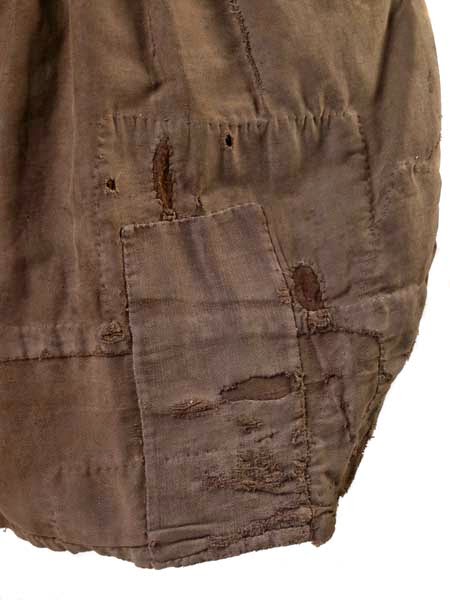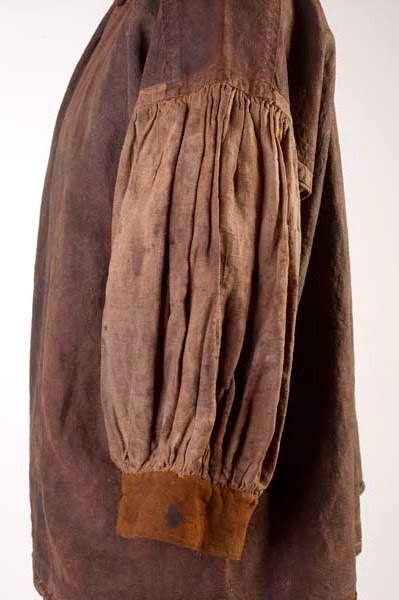18TH CENTURY LIVING HISTORY, HISTORICAL TREKKING, AND PERIOD WILDERNESS LIVING.
A LIVING HISTORY BLOG.
18TH CENTURY LIVING HISTORY IN AUSTRALIA.
Saturday, 31 May 2014
Colonial Pemaquid: Outpost On The 17th Century Maine Frontier (also a thatching demo).
Labels:
17th century living,
18th century life,
america,
colonial,
England,
homes,
houses,
living history,
New World,
survival,
thatching,
wattle and daub,
wilderness living
Australia
Maine, USA
Monday, 26 May 2014
Kitchen - History of the Home [1/4]
Labels:
17th century,
18th century,
cooking,
faggots,
fire,
firewood,
food,
forest,
hearth,
hooks and crooks,
kitchen,
ovens,
pimps,
wood collection
Australia
England, UK
Bathroom - History of the Home [2/4]
Interestingly enough, I still remember some of these items in our 18th century family home, and also in my Grandparents home in South Wales. Wash bowls were accompanied by water jugs in each bedroom. We even had a closed stool with a fancy embroidered top to the lid.
When I moved to Australia and got married we lived a similar sort of lifestyle, though we did wash every day! With no water on tap, water had to be carried in and was heated in large kettles over the open fire, suspended on chains and hooks hanging from an old buggy axle. The toilet was an ash can in an outhouse. Our three boys were bathed in a tin bath in front of the fire just as I was when I was a child. The outhouse was also equipped with a wash bowl and water jug. We lived this 18th century lifestyle for about 20 years.
Keith.
Labels:
17th century,
18th century,
bath,
bathing,
Bathroom,
toilet,
wash bowl,
washing
Australia
England, UK
Fimbulmyrk: Historical swords and cutlery in the Klingenmuseum...
Fimbulmyrk: Historical swords and cutlery in the Klingenmuseum...: You all have read my post about the Knifemaker´s Fair in Solingen Klingenmuseum which...
The Sealed Knot and The 30 Years War. Promotional Video. Short.
Labels:
17th century,
30 years war,
arms and Armour,
England,
Historical,
history,
living history,
reenactment,
the Sealed Knot
Australia
England, UK
Sunday, 25 May 2014
Canoe Construction-Australian National Maritime Museum.
Bark Canoe building at Bents Basin –a NPWS Sydney Aboriginal Community Cultural Gathering
Friday, 23 May 2014
The Old Foodie: To Make a Pye to Keep Long.
The Old Foodie: To Make a Pye to Keep Long.: In the days long before refrigeration, one way of keeping meat for a prolonged period was to bake it in a pie – a particular sort of pie th...
Thursday, 22 May 2014
COLONIAL AMERICAN DIGRESSIONS: COLONIAL OCCUPATION: POTTER
COLONIAL AMERICAN DIGRESSIONS: COLONIAL OCCUPATION: POTTER: Potter's Kick-Wheel Courtesy of Wikisource Dear Reader, The wooden bar at bottom left of the image, connecte...
The Oilcloth & The Blanket, Questions Answered. Video.
"This morning an account was bro't to town, that
a large army of French
and Indians were seen at a small distance from the
German flats, but few
here believe it. Sir William Johnson is still in
readiness, with 1500 of
the militia. Every man in the French army that came
against Fort William
Henry, was equipped in the following manner, viz. With
two pair of
Indian shoes, 2 pair of stockings, 1 pair of
spatterdashes, 1 pair of
breeches, 2 jackets, 1 large over-coat, 2 shirts, 2
caps, 1 hat, 1 pair
of mittens, 1 tomahawk, 2 pocket-knives, 1 scalping
knife, 1 steel and
flint, every two men an ax, and every four a kettle
and oilcloth for a
tent, with one blanket and a bearskin, and 12 days
provision of pork and
bread; all which they drew on little hand-sleighs."
Extract of a letter from Albany, dated April 2, 1757
printed in the
Boston
Gazette, April 18, 1757.}
Labels:
18th century,
blankets,
comfort,
historical trekking,
oil cloth,
oilcloth,
survival,
Video,
wilderness living,
winter camping,
woods women,
woodsmen,
woodsrunners
Australia
Australia
Wednesday, 21 May 2014
An Embroidered Cap from The 1642 Tailor.
Labels:
1642,
17th century,
cap,
clothing,
embroidered,
headwear,
Historical,
Link,
living history,
tailor
Australia
England, UK
Tuesday, 20 May 2014
The Old Foodie: The Right Management of Oatmeal.
The Old Foodie: The Right Management of Oatmeal.: William Ellis (c1700-1758) was a farmer in Herefordshire, England, who became a prolific and popular writer on agriculture and rural domest...
Sunday, 18 May 2014
The Old Foodie: A Tax Upon Your Fireplace.
The Old Foodie: A Tax Upon Your Fireplace.: When Charles II was restored to the throne of England in 1660, Parliament granted him annual income of £1,200,000. Unfortunately for the ge...
School of the Renaissance Artisan: Continuing on with Costrels, Cordwaining, and 6th ...
School of the Renaissance Artisan: Continuing on with Costrels, Cordwaining, and 6th ...: Welcome back. Where was I? My workbench is such a mess right now... Oh, yes... cordwaining. We were making shoes, weren't we? ...
Thursday, 15 May 2014
COLONIAL AMERICAN DIGRESSIONS: FRENCH ENCIRCLEMENT OF THE ENGLISH NORTH AMERICAN...
COLONIAL AMERICAN DIGRESSIONS: FRENCH ENCIRCLEMENT OF THE ENGLISH NORTH AMERICAN...: Dear Reader, This is the last part in a series. If you would like to start with Part One, go here: http://www.da...
Wednesday, 14 May 2014
Chasing the Deer - 1995 - Full movie about Jacobite rising 1745
Labels:
1745,
18th century,
Celtic,
film,
Jacobites,
living history,
movie,
Scotland,
Scots,
Scottish,
Video,
war
Australia
Scotland, UK
The Old Foodie: Serving up Sage.
The Old Foodie: Serving up Sage.: Yesterday’s recipe using clary got me thinking about the other varieties of sage, and made me realise how little blog space I have allocate...
Possible discovery of Columbus’s flag ship SANTA MARIA (1492)
1892 replica of Santa Maria photographed in 1904 possibly by Edward H Hart.
Source: United States Library of Congress via Wikimedia Commons
Tuesday, 13 May 2014
The Old Foodie: A Bill of Fare for May, in 1737.
The Old Foodie: A Bill of Fare for May, in 1737.: Yesterday I gave you a recipe for fresh vermicelli from one of my favourite eighteenth century sources. I have to admit that part of the re...
Monday, 12 May 2014
The Old Foodie: Macaroni Yesterday, Vermicelli Today.
The Old Foodie: Macaroni Yesterday, Vermicelli Today.: As I mentioned yesterday, the early English references to ‘macaroni’ do not specifically indicate the short tubular form of pasta as the wo...
Costume Historian: Hollar's ladies in winter clothing 1639-1649
Costume Historian: Hollar's ladies in winter clothing 1639-1649: Figure 1 - Pennington 609 Wenceslaus Hollar (1607-1677) published a large number of costume prints in the middle of the seventeenth cent...
More on Travel in the 18th Century.
Labels:
18th century,
colonial,
Historical,
living history,
reenactment,
transport,
travel,
wagons
Australia
North America
Project Gutenberg's Stage-coach and Tavern Days, by Alice Morse Earle
Labels:
17th century,
18th century,
colonial,
England,
living history,
stage coach,
stage wagon,
Taverns,
transport,
travel
Australia
United States
Sunday, 11 May 2014
The Old Foodie: A Cheap, Fresh, and Lasting Victual for Seamen.
The Old Foodie: A Cheap, Fresh, and Lasting Victual for Seamen.: The provisioning of ships was a great pre-occupation of Naval authorities, scientists, and medical men in the days when ships set off on lo...
17th Century Clothing Image.
Labels:
1600s,
17th century,
clothing,
living history,
men's wear,
reenactment
Australia
England, UK
Slops Breeches 1600-1700 Museum of London.
Slops Breeches 17th century-18th century.
Labels:
1600,
1700,
17th century,
18th century,
living history,
museum of London,
pirates,
Privateers,
reenactment,
sailor's clothing,
seaman,
slops
Australia
London, UK
Friday, 9 May 2014
This Week In Pennsylvania Archaeology: E is for Effigy
This Week In Pennsylvania Archaeology: E is for Effigy: You have seen the word effigy in several of our blogs. We most often use it when referring to our departmental logo the Washington Boro Fa...
Seaman's Slops. Museum Of London.
According to the museum of London this style of clothing was worn by seamen from the 16th century (1500s) into the 18th century (1700s).
Front
Back.
Notice the pattern on the main body of the frock. This is apparently made from Lindsey Wolsey, a mix of linen & wool.
http://collections.museumoflondon.org.uk/Online/object.aspx?objectID=object-83031&rows=1&start=2&sort=summaryTitle%20asc;
Labels:
16th century,
18th century,
breeches,
clothing,
frock,
images,
living history,
mariners,
museum of London,
reenactment,
sailors,
seamen's slops,
slops
Australia
London, UK
Tuesday, 6 May 2014
Monday, 5 May 2014
Making A Simple Leather Sword Scabbard Frog. Short Video.
No special tools used during this construction. I made my own awl, and I cut the leather with my clasp knife. I used a fire log to place the leather on to make the holes. It took me about an hour to make.
Labels:
17th century,
18th century,
blades,
colonial,
crafts,
DIY,
English,
frog,
homemade,
hunting sword,
leatherwork,
living history,
primitive skills,
scabbard,
settler,
sheath,
Video
Australia
New England, Australia
Subscribe to:
Comments (Atom)













































